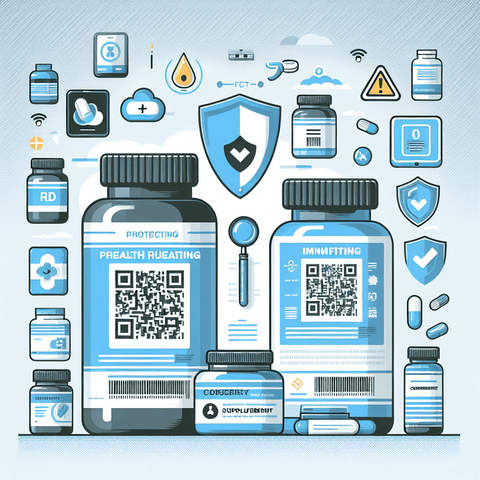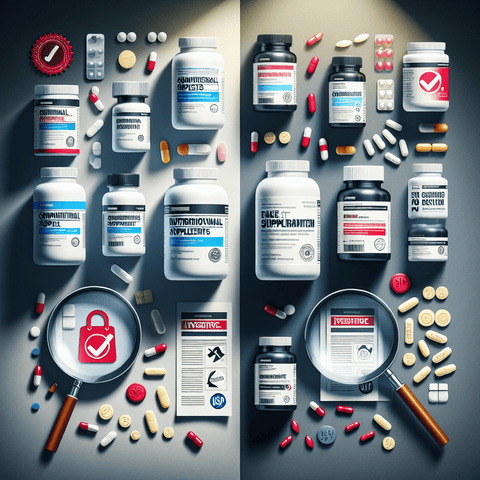Introduction
The global dietary supplement industry is booming. With increasing awareness of health and wellness, more people are turning to nutritional supplements to complement their daily diets. From supporting bone health to boosting immunity and enhancing energy levels, supplements such as vitamin C, vitamin D, and magnesium have become staples in many households. However, this popularity has also attracted counterfeiters eager to profit from unsuspecting consumers.
Counterfeit supplements pose serious risks to health. Unlike genuine products, fake supplements may contain harmful substances, incorrect ingredient dosages, or no active ingredients at all. Consumers who purchase these illicit products not only waste their money but may also compromise their health. The counterfeit supplement problem is not limited to a few isolated incidents—it’s a global concern that infiltrates both online and offline markets.
This smart shopper’s guide is designed to empower you with the knowledge and tools you need to identify and avoid counterfeit nutritional supplements. Whether you shop online or in stores, understanding how to recognize fake products is crucial. This guide will walk you through the risks of counterfeit supplements, how to spot fakes, the tools and methods for authentication, and how to verify trustworthy sources like topvitamine.com.
Your health is your most valuable asset. Ensuring that the supplements you take are authentic, safe, and effective is not only smart—it’s essential.
Understanding the Risks of Counterfeit Supplements in the Nutritional Market
Counterfeit supplements are unauthorized products made to look like legitimate dietary or nutritional items. These fakes may imitate the packaging, branding, and marketing claims of reputable products, making them difficult to distinguish from the real thing. The global supplement market's size and decentralized nature create opportunities for counterfeiters to introduce these products into the supply chain covertly.
Health risks are among the most serious concerns associated with counterfeit supplements. Many fake products contain undeclared or harmful ingredients such as heavy metals, steroids, or pharmaceutical substances. Some may include allergens not listed on the label, posing life-threatening risks for people with sensitivities. Even in the absence of toxic components, counterfeit supplements can be dangerous because they often lack the proper dosages of active ingredients, rendering them ineffective or misleading consumers about their benefits.
Effectiveness is another concern. Imagine purchasing an omega-3 supplement that claims to support brain and cardiovascular health. If the product lacks the essential DHA and EPA components typically found in high-quality omega-3 supplements, its efficacy is null, and any expected benefits are never realized. Worse, prolonged use of ineffective supplements could delay proper treatment or intervention.
Counterfeit supplements enter both online and brick-and-mortar stores through convoluted supply chains and poorly regulated vendors. Some are produced in unlicensed facilities lacking quality controls. In unregulated online marketplaces, consumers are especially vulnerable, often encountering listings for underpriced supplements or irrelevant third-party sellers posing as authorized retailers.
Commonly counterfeited supplements include high-demand products such as multivitamins, protein powders, weight loss capsules, sexual health enhancers, and popular single-ingredient options like vitamin K, vitamin D, and herbal extracts. These are attractive targets for counterfeiters due to their mass-market appeal and relatively high retail prices.
Understanding the serious risks of counterfeit supplements helps highlight the importance of due diligence. Your health depends on what you put into your body. Ensuring its authenticity is more important than ever—especially in a marketplace increasingly infiltrated by unscrupulous actors.
How to Spot Fake Dietary Supplements Before You Buy
Spotting a fake dietary supplement isn't always easy, but there are warning signs if you know what to look for. The first major red flag is unrealistic claims. Phrases like “lose 10 kg in one week” or “instantly cure arthritis” are clear signs of deceit. The European Food Safety Authority (EFSA) and other regulatory bodies heavily restrict such unsupported health claims—perhaps the quickest way to recognize a product outside regulatory boundaries.
Another common red flag is unusually low pricing. Supplements have a standard price range influenced by ingredient quality, production regulation, and third-party certification. If you find a supplement that costs drastically less than comparable products, it might be too good to be true. In such cases, you may be dealing with a counterfeit or expired product being resold illegally.
Packaging quality can offer numerous clues. Check for inconsistencies in color, font, or images compared to what you’ve seen on the manufacturer's official website. Pay attention to misprints, grammatical errors, or altered product names. Authentic brands invest significantly in professional design—counterfeiters usually don’t.
Label discrepancies are significant indicators. Authentic products include lot numbers, expiration dates, suggested use, and detailed ingredient lists. Be wary if any of this information is missing or poorly printed. Also, packaging should display manufacturing and distributor information. The absence of these could suggest non-compliance with safety standards.
Before buying, evaluate the credibility of vendors and websites. Search for the company’s contact info, return policy, and privacy standards. Be cautious of websites without HTTPS encryption or those that conceal critical company information. A legitimate retailer, such as topvitamine.com, offers full transparency about its sourcing, product range, quality controls, and customer service policies.
To better illustrate, let’s compare two labels of the same product—one authentic, one counterfeit. The real version from a verified source includes a QR code linking to third-party test results, an embossed logo seal, a proper lot and expiry code, and a glossy, high-resolution label. The fake version, however, has fuzzy print, inconsistent color, incorrect spelling (“Adult Mulyivitamin”), and no QR or batch details. Such small errors often indicate significant deceit.
By staying alert and scrutinizing every aspect of a product and seller, you dramatically reduce the chances of buying a counterfeit supplement. Being a skeptical and informed shopper is your best protection.
Supplement Authenticity Check — Tools and Methods That Work
Technological advancements have made it easier for consumers to verify the authenticity of dietary supplements. Many legitimate manufacturers now incorporate tools directly into product packaging or in conjunction with their websites. Here’s how you can conduct your own supplement authenticity audit.
The first thing to look for is a QR code or batch code. Scanning a manufacturer-provided QR code will often direct consumers to a dedicated webpage that shows the production date, plant of origin, and third-party testing results. These digital imprints are difficult for counterfeiters to replicate and provide strong verification of product legitimacy.
Holograms and tamper-proof seals are additional authenticity indicators. These security features are normally found on the lid or neck of bottles. Look for holographic images that change when tilted, or clear information embedded within the seal material. If the seal appears loose, broken, or different from what you’ve seen previously for the same brand, don’t buy the product.
Another excellent method is using manufacturer-supported authentication apps. Some well-known brands maintain mobile applications or forward you to digital verification platforms where batch numbers can be entered manually to determine authenticity. These systems act as digital passports, with each lot having a unique identifier in the company’s secure database.
Third-party testing is crucial. Certifications from organizations like NSF, USP, and GMP (Good Manufacturing Practices) indicate that the supplement has met rigorous safety and quality criteria. The NSF certification, for example, verifies that the product contains the ingredients listed on the label and has no unsafe levels of contaminants. USP ensures bioavailability and GMP indicates that the product was manufactured in a quality environment.
Conducting your audit involves a few logical steps:
- Check for a QR or barcode on the packaging and scan it.
- Examine the lid and neck area for tamper-evident features.
- Compare the packaging with official website product images.
- Enter the batch or lot number on the manufacturer's site, if available.
- Look for recognized third-party certifications like GMP or NSF.
Taking these steps reassures you that what you're consuming meets rigorous safety and quality criteria. For ease and peace of mind, choose supplements from reputable platforms like topvitamine.com, which only stocks validated, authenticity-checked products.
Spotting Fake Vitamins Online and In-Store
Purchasing vitamins through e-commerce platforms or local stores can be convenient, but it also requires heightened vigilance. Fake vitamins continue to circulate across popular marketplaces due to the sheer number of sellers and limited regulatory oversight. Here's how you can tell if what you're buying is authentic or counterfeit.
On platforms like Amazon or eBay, fake listings often appear among authentic ones. They may use stolen images and promotional text. The most obvious giveaway is pricing—if it’s drastically discounted, it’s likely counterfeit. Take a moment to review the seller. Authorized sellers are usually listed as the official retailer or manufacturer. Third-party sellers with no storefront, vague brand names, or recently opened accounts should be treated with caution.
Customer reviews can provide useful insight—but they can also be manipulated. Extremely generic reviews or sudden influxes of five-star ratings often indicate a fake review campaign. Read both high and low ratings for information on product consistency, packaging irregularities, or adverse effects. Watch out for “Verified Purchase” labels coupled with detailed experiences aligned with advertised benefits. If every review is vague or over-the-top in praise, be suspicious.
In physical stores, be cautious of supplements located outside the health or pharmacy sections, especially if heavily discounted. Chain stores and pharmacies typically have systems in place to prevent fake products—but smaller or independent shops may lack similar safeguards. Counterfeit supplements may also be placed near checkout areas where impulse buying is common. Examine packaging and seals, and never purchase a supplement with damaged casing.
Purchasing directly from authorized retailers eliminates many of these risks. Top-tier sites like topvitamine.com deal only with verified distributors and include detailed product listings along with transparent contact information and verified security certifications. Buyers should also be wary of foreign websites with poor translations, hidden shipping costs, or no customer service.
The bottom line: Always verify the source and perform a packaging analysis before purchasing supplements, whether online or in-store.
Learn How to Identify Counterfeit Products Using Packaging and Product Details
Carefully examining the physical characteristics of a supplement can help you determine its authenticity. It starts with the packaging—a powerful line of defense against counterfeiters if you know what to look for.
Genuine supplement containers come with tamper-evident features such as heat-sealed foils under the lid, shrink bands, or breakable locks. These safety measures ensure that once opened, the product cannot be resealed without noticeable evidence. If your product arrives with inconsistent sealing or loose caps, it may have been tampered with or replaced entirely.
Brand consistency is another important clue. Compare the suspected item with an image of the genuine product on the manufacturer’s official website or a reputable retailer like topvitamine.com. The positioning of labels, logo dimensions, and use of color should align exactly. Any deviation could indicate a counterfeit.
Always check for essential labeling details: expiration date, batch or lot number, recommended dosage, ingredient composition, and contact information for the manufacturer. Additionally, the label should confirm the product category and usage restrictions, often expressed with statements like “Food supplement" or “Keep out of reach of children." These are indicators of regulatory compliance.
Smart shoppers use small tools to enhance verification. A magnifying glass can reveal micro text inconsistencies. A UV light may help spot invisible inks used in legitimate packaging. Barcode scanning apps can help match packaging with database entries displaying the supplement’s full supply chain.
Before you buy, consult the following checklist:
- Is there a tamper-evident seal intact?
- Does packaging quality align with known brand standards?
- Are the expiry and batch codes legible and accurate?
- Are third-party certifications present?
- Can the product branding be verified via official website?
Following such a checklist dramatically increases your ability to detect fakes and make safer purchasing decisions.
How to Verify Supplement Sources for Safe and Informed Buying
To avoid counterfeit supplements and ensure product integrity, your choice of supplier plays a critical role. Look for retailers offering verifiable proof of quality and transparency. Certified online stores like topvitamine.com stand out by providing products from approved, regulated manufacturers, complete with digital verification tools and legitimate safety seals.
Researching the brand before purchasing is also essential. Start by checking the company's Better Business Bureau (BBB) listings or trust score on consumer forums. Look for industry accreditations such as NSF, USP, or participation in EU regulatory schemes. An established supplement company typically has a long history, verified contact info, and available clinical data on their formulations.
Another sign of credibility is access to responsive customer service. Reputable brands provide multiple communication channels—email, phone, or live chat—to assist with issues like product returns, batch confirmations, or dosing inquiries. Lack of customer support often signals a shady operation.
Regulatory support serves as the foundation of supplement legitimacy. While supplements are not directly approved by the FDA or EFSA in the same way pharmaceuticals are, these agencies provide strict regulations for safety claims, labeling, and distribution. The public domain of the EFSA compiles information on permitted claims and ingredients. Products not complying with these guidelines are at risk of enforcement action and could endanger consumer safety.
By confirming all this information before your purchase, you transition from a passive buyer to an informed, proactive one. Trusting sites like topvitamine.com, known for transparency and accuracy, is a step toward supplementing your health safely.
Conclusion: Be a Smart Supplement Shopper
Counterfeit supplements are a growing threat to your health, finances, and wellness goals. These illicit products infiltrate both online and offline markets, disguised as legitimate solutions to your nutritional needs. By understanding the risks, knowing how to spot fake supplements, using verification tools, and shopping from verified sources, you significantly increase your odds of purchasing a safe and effective product.
Remember to analyze packaging, question unbelievable claims, research your sources, and use authentication tools such as QR codes and batch verifiers. Educating yourself is the first and strongest line of defense. Reliable retailers like topvitamine.com make this easier by offering products that meet the highest standards in safety, sourcing, and transparency.
When your health and wellness are on the line, make smart choices. Invest in quality, verify your sources, and protect yourself from the hidden dangers of counterfeit supplements.
Q&A Section
Q: What are the primary dangers of counterfeit supplements?
A: Counterfeit supplements may contain harmful or unknown ingredients, incorrect dosages, or no active ingredients—all of which can result in serious health consequences and a lack of efficacy.
Q: What are red flags when purchasing supplements online?
A: Unrealistic claims, excessively low prices, vague seller profiles, misspelled labels, and missing safety information are common signs of fake supplements.
Q: How do I verify a supplement’s authenticity?
A: Use QR or batch codes, check third-party certifications (NSF, USP, GMP), inspect packaging quality, and compare with images on official seller websites like topvitamine.com.
Q: Are customer reviews reliable?
A: While often helpful, not all reviews are trustworthy. Look for verified purchases with detailed, balanced insight and be cautious of exaggerated praise or spam-like reviews.
Q: What are safe places to buy supplements?
A: Trusted online retailers like topvitamine.com that offer certified supplements from regulated manufacturers with transparent labeling and authentication tools.
Important Keywords
Counterfeit supplements, fake vitamins, supplement authenticity, genuine packaging, QR code verification, batch number authentication, dietary supplement safety, third-party tested supplements, supplement fraud prevention, supplement buyer guide, trusted supplement sources, topvitamine.com, NSF-tested supplements, USP-certified vitamins, GMP supplement standards.



